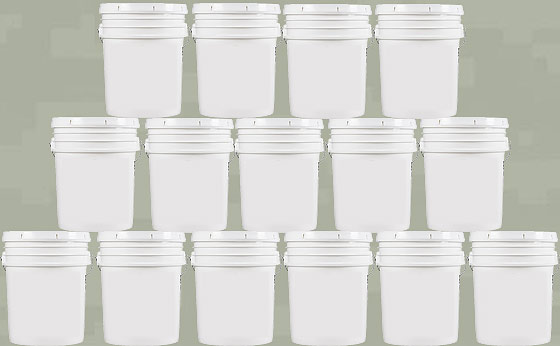DIY Long Term Food Storage

You might say there are three methods to securing long term food storage. A favored way is a DIY long term food storage. That is, do-it-yourself…
1. Buy ready-made, already packaged for long term food storage.
2. DIY long term food storage.
3. A combination of both.
DIY or do it yourself, is probably the most popular method for most preparedness-minded people. Why? Because it gives you control over what your long term food storage looks like. I’ve done a combination of both DIY, and, purchasing some ready-made buckets of various dry goods.
I’ve updated this original content for any newbies to preparedness out there. Or for those who land here via a search. I also advise that you browse the “Survival Kitchen” category for more advice…
DIY Long Term Food Storage Advantage
– You choose the specific foods
– The method(s) of packaging
– How it’s all packed and organized
– Basically, you choose everything…
Disadvantages ?
– Potential for mistakes (although low)
– Time (it takes time and effort)
First let me say this. There are plenty of good choices out there for simply purchasing ready made quantities of long term food storage.
If for whatever reason(s) you are not able to commit the time required to do it yourself, go ahead and simply buy a survival food kit for 30 days, 3 months, whatever you’re comfortable with.
Personally over the years, I have purchased a number of ready made foods already packed for the long term. I also DIY. I diversify.

You might consider long term food storage options from small USA business owner Bob Griswold & Family, over at Ready-Made-Resources who is a distributer for a number of quality long term food storage vendors. Mountain House, Numanna, Augason Farms, Lindon Farms, Wise, Werling & Sons (bulk canned meats), and more. Yes, they have been a long term advertiser with us for over a decade. Good people.
DIY Long Term Food Storage Food Choices
Awhile ago I polled our readers to discover their most popular ‘survival food’ items stored as part of their overall food storage plan.
[ Read: Survival Food Most Common In Preppers Deep Pantry Storage ]
Here are the Top 10 Food Items For DIY Long Term Food Storage
(some were a tie)
1. Rice
2. Beans (dry)
3. Wheat berries (for flour)
4. Canned Meat
5. Canned Veggies
5. Pasta
5. Honey / Sugar
6. Oats
7. Salt
7. Dry Milk
8. Flour
9. Coffee / Tea
9. Freeze Dried Meats
9. Freeze Dried Veggies
10. Yeast
[ Read: Best Hand Grain Mill Choices For Wheat – Flour – Grains ]
Just FYI, I want to mention that the combination of Rice & Beans is one of the most economical and easiest ways to quickly secure some calories for your own DIY long term food storage.
Rice is rich in starch, and an excellent source of energy. Beans are rich in protein, and contain other minerals. The consumption of the two together provides all the essential amino acids and it is no wonder that this combination is a staple of many diets throughout the world.
[ Read: Rice and Beans, A Survival Combination ]
I also want to mention this… From a long term food storage perspective that focuses on survival, you need to get a good approximate understanding of the calories that you are storing. At the end of the day, it’s about the calories. Nutrition and diversification too!, but you’ve got to have enough calories.
Lots of calories can fit in a 5 gallon bucket of rice, beans (dry), and wheat (berries).
In fact all three are pretty close in number. About 50,000 calories in a 5 gallon bucket of each. Or you might say about 25 survival days per filled bucket.
[ Read: The Calories in a 5-Gallon Bucket of Rice, Beans, and Wheat ]
Additionally, did you know this…? One 5 gallon bucket of wheat berries will produce about 25 loaves of bread.
[ Read: How Much Wheat in a 5 Gallon Bucket – Pounds, Calories, #Loaves Bread ]
Make Your Own DIY Combo Food Bucket
Recently on the blog there was mention of DIY combo 5-gallon buckets. More specifically, diversifying what goes inside a given bucket (rather than all one food in each).
That’s a pretty interesting concept because you can tailor it however you want!
Why might this be a good way to do it? Because a single bucket could be set up as a standalone ready-to-go well rounded emergency food deployment. Grab-n-go, or simply a more efficient way of dealing with food during an emergency (rather than having to open and unseal lots of buckets to get your diversification).
Just thinking off the top of my head, you might do a combination of something like this in a single bucket…
Of course each of these items would be separately packaged, vacuum sealed, Mylar bag, etc.. within the bucket itself.
– rice
– beans (dry) (variety)
– oats
– salt
– sugar
– spices (gotta have spices!)
Whatever floats your boat… it’s all DIY.
I recommend that you separately vacuum seal ingredients such as rice, beans, oats. Why? By removing the air (oxygen) it will greatly increase the shelf life.
Here’s one that’s not very expensive, compact design:
NESCO Food Vacuum Sealing System
(amzn)
[ Read: Vacuum Sealer Uses – Things You Can Seal With A Food Saver Machine ]
DIY Seal Your Own Mylar Bags
When purposely storing dry foods for long term storage in 5 gallon buckets, the general “how to” process is as follows:
1. Insert a mylar bag into the pail.
2. Fill it up (e.g. rice).
3. Drop in 2,000 cc Oxygen Absorbers.
4. Seal the mylar bag.
5. Secure the cover to the bucket.
All of this takes time and requires that you purchase the necessary materials.
I wrote about this several years ago:
[ Read: How to Seal a Mylar Bag in a 5-gallon bucket ]
The article addresses food grade buckets, oxygen absorbers, mylar bags and how to seal them.
Diversify Food Types While DIY
The best DIY long term food storage will be a diversified set of foods as well as the way they’re processed and packaged.
Purchasing a 3 month survival food kit from a vendor may be enough to keep you alive when you need it. Procuring your own diversified sets of food storage (if done properly) will provide a balance of variety, tastes, nutrition, cooking methods, and other benefits that you will control.
– 5 gallon buckets of various dry goods
– 5 gallon combo buckets
– home canned foods of your choosing
– store bought canned foods, meats
– store bought pastas, sauces, spices, and whatever else…
– dehydrated foods
– freeze dried foods
– special treat foods (sweets!), fruits
Food Storage Mistakes
Do you know about the four big things that can be bad for your long term food storage?
– Temperature
– Moisture Content
– Atmosphere
– Container
[ Read: 4 Things That Affect Food Storage ]
Did you know that temperature greatly affects the shelf life of your food storage?
Example: A can of food with a specified shelf life of 2 years (at room temperature 72 degrees F) will actually reduce to one year if stored at 90 degrees F.
[ Read: Temperature Versus Food Storage Shelf Life ]
Other Mistakes To Avoid
– Buying too much food that you don’t normally eat
– Not diversifying
– Getting started, but not finishing
– Failure to rotate your foods
– Losing track of what you have
– Too much freezer food (will you always have electricity?)
– Not enough spice!
[ Read: Food Storage Mistakes To Avoid ]
SUMMARY
In closing, regardless of how you acquire or what you choose for your own DIY long term food storage, just do “something”. Don’t feel guilty about taking the easy way out and buying a ready-made kit (see our sponsor link near the beginning). It’s simply common sense preparedness.
For others I’m preaching to the choir. You already are beyond long term storage and are into self-sufficiency replenishment (self sustaining gardening, etc..). It still doesn’t hurt to examine what you do have though. Diversify!
[ Read: Food Storage List For 1 Year ]
